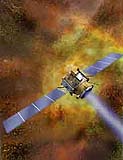| . |  |
. |
 Space Rescue Makes Deep Space Comet Encounter Possible
Space Rescue Makes Deep Space Comet Encounter PossiblePasadena - July 27, 2000 - As NASA's Deep Space 1 propels itself through the solar system about 320 million kilometers (about 200 million miles) from Earth, the tiny spacecraft has been reenergized for a planned September 2001 encounter with Comet Borrelly. Deep Space 1 met or exceeded all of its primary mission objectives of testing 12 advanced, high-risk technologies in September 1999, providing important data for future users. However, engineers and scientists at NASA's Jet Propulsion Laboratory, Pasadena, CA, believed that even further challenges could be met. NASA approved an extended mission in order to gain more scientific knowledge of comets. "NASA decided that it could afford to go ahead with a risky extended mission," said Paul Hertz, NASA Headquarters program executive for Deep Space 1. "The talented Deep Space 1 folks at JPL are working hard to squeeze a bonus science mission, an encounter with Comet Borrelly, out of this already successful mission. Although there is no guarantee of success, trying for the comet makes much more sense than just turning the spacecraft off." Shortly after it began traveling to meet the comet, Deep Space 1 lost a critical sensor -- its star tracker -- to determine and control its orientation system. "We had to rebuild a significant part of the spacecraft from hundreds of millions of kilometers away and complete it to begin ion-powered flight in time to keep our date with Comet Borrelly," said Project Manager Dr. Marc Rayman. "This was crucial, because the star tracker that had been used previously to determine the spacecraft's orientation in space failed in November 1999." The star tracker determined orientation by tracking the positions of stars. Without the star tracker, Deep Space 1 did not know in which direction it was pointed. It couldn't thrust in the direction of the comet, since it didn't know which way to go. Use of the newly developed camera method allowed the spacecraft to regain full three-dimensional control. Engineers at JPL radioed software to the spacecraft to reprogram the camera on board to serve as a replacement for the lost star tracker. This boost is helping Deep Space 1 go on to perform a mission that is above and beyond the plans at launch. "In a very short time, the spacecraft operations team developed a very complex and innovative new system that gives Deep Space 1 a new chance to try to reach the comet," said Rayman. "The new system is working beautifully. I think this is one of the most impressive in-space rescues ever completed." With Deep Space 1 knowing its orientation in space, controllers instructed the ion propulsion system to resume thrusting. Return data showed that the system was operating successfully and the spacecraft is on its way to Comet Borrelly. Now that the software enables the spacecraft to point its antenna toward Earth on its own, more software will be transmitted to the spacecraft in February 2001. Among the differences between the star tracker and the camera is the amount of sky that each views. The camera sees an area only a bit larger than the full moon as viewed from Earth, but the star tracker covers well over 100 times as much area. Both can see stars that are fainter than the unaided human eye can detect. The star tracker would update the spacecraft computer four times per second, while the camera produces a computer file containing a picture. It then takes 20 seconds to transfer the picture to the computer for analysis. The navigation system processes the picture and delivers the result to the attitude control system. Scientists plan to image the comet's nucleus and the environment around it as well as collect infrared measurements to determine its composition. They will also measure charged particles in the vicinity of Borrelly, including the interaction of the comet with the solar wind.
DEEP SPACE ONE
|
| |||||||||
| The content herein, unless otherwise known to be public domain, are Copyright 1995-2016 - Space Media Network. All websites are published in Australia and are solely subject to Australian law and governed by Fair Use principals for news reporting and research purposes. AFP, UPI and IANS news wire stories are copyright Agence France-Presse, United Press International and Indo-Asia News Service. ESA news reports are copyright European Space Agency. All NASA sourced material is public domain. Additional copyrights may apply in whole or part to other bona fide parties. Advertising does not imply endorsement, agreement or approval of any opinions, statements or information provided by Space Media Network on any Web page published or hosted by Space Media Network. Privacy Statement All images and articles appearing on Space Media Network have been edited or digitally altered in some way. Any requests to remove copyright material will be acted upon in a timely and appropriate manner. Any attempt to extort money from Space Media Network will be ignored and reported to Australian Law Enforcement Agencies as a potential case of financial fraud involving the use of a telephonic carriage device or postal service. |